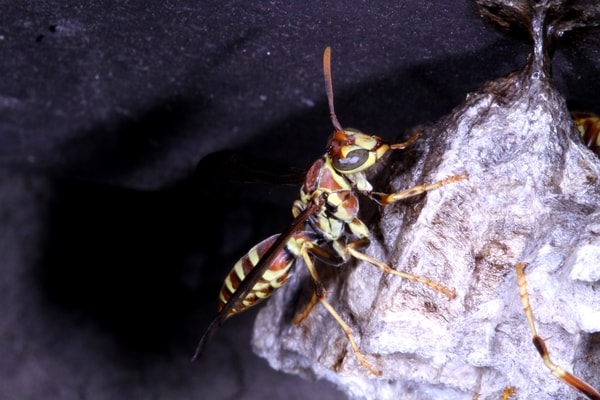
WHAT DOES A PAPER WASP NEST LOOK LIKE?
You would likely recognize paper wasps (Order Hymenoptera: Family Vespidae) based on the structure of their nests. Their umbrella-shaped nests are made of a gray papery substance, and you may have seen one attached to the ceiling of your covered outdoor porch. These types of nests can also be found on tree limbs, chimneys, support beams in attics, garages, barns and other sheltered areas. There are several species (Polistes species) of paper wasps found in North America.
A female wasp, who becomes the queen, starts building her nest by secreting a pulp-like papery substance. This substance is a mixture of plant fibers and saliva. Hexagonal-shaped openings in the nest are used to house the progeny of paper wasps. The queen lays a single egg in each cell of the nest. Each egg develops into a larva and is fed a diet of arthropods (e.g., caterpillars, spiders) for about 1.5 months until the larva subsequently transforms into a pupa, and, finally an adult. There are 12 to 100 paper wasps per colony. These wasps operate in a caste system similar to ants where there is usually one queen, although some colonies may have more than one queen, and several non-reproductive workers that are in charge of foraging for food and tending to the queen and her progeny.
Architects have acknowledged that the joined hexagon-shaped compartments of a paper wasp nest are a very efficient use of space for housing the wasp larvae. Some architects have even used hexagon shapes that mimic wasp nests in the construction of buildings.
WHAT IS UNIQUE ABOUT PAPER WASP SALIVA?
Paper wasps use their saliva to waterproof their nests. A team of scientists have reproduced the proteins from paper wasp saliva and used this substance to waterproof an unmanned aerial vehicle (i.e., drone).
WHAT DO PAPER WASPS EAT?
Paper wasps may be considered beneficial insects because they are predators of other arthropods, such as insects (e.g., caterpillars) and spiders. Gardeners often appreciate that wasps prey on garden pests, such as caterpillars. Adult paper wasps immobilize and feed the prey arthropods to their developing progeny; however, adult wasps feed primarily on sugar (e.g., ripe fruit, honeydew, nectar).
WHEN SHOULD I EXPECT TO SEE PAPER WASPS?
During fall months when temperatures begin to cool, some wasp females mate with male paper wasps. Male wasps die shortly after mating. Mated females find shelter for the winter in covered areas, such as attics, tree hollows or other protected areas. You might observe several mated females clustering together during the winter period.
When warmer spring temperatures arrive, new nests are built by mated female wasps (generally not related to each other). Dominant female paper wasps will begin building nests for egg laying and may even overtake nests of other (less dominant) females. In some cases, large numbers of females will continue construction on an existing nest and nests can be reused for multiple years.
CAN PAPER WASPS HURT ME?
Social wasps, like paper wasps, will defend their colony by stinging, hence people should be cautious when wasp nests are observed. Outdoor workers may come into contact with paper wasps more frequently than the general public, hence, they must take extra precautions to avoid exposure to stings, especially if they are allergic to them. Immune reactions to stings vary between individuals and can range from local swelling at the sting site to widespread systemic reactions and even to death (though rare). People may exhibit cross reactivity to venom from different species of hymenoptera (e.g., someone that shows a severe reaction to a paper wasp sting may also have a reaction to a honey bee or bumble bee sting and vice versa).
Unlike honey bee stingers that are straight and have external barbs, paper wasp stingers are curved and have internal barbs (Zhao et al. 2015). A study examining the differences in honey bee and paper wasp stings showed the honey bee took 1.5 seconds to complete the stinging process, while the paper wasp took only 0.5 second (Zhao et al. 2015). Paper wasps can easily remove their stinger from their victim, unlike honey bees. This may allow wasps to sting multiple times.
IS THERE ANYTHING I CAN DO TO HELP PREVENT PAPER WASPS FROM ENTERING MY HOUSE?
Sealing potential entry points is the best method for helping prevent establishment of wasp colonies in areas such as attics. Nests observed on porches, along eaves, or other areas should be professionally removed and destroyed. The earlier a nest is observed, the easier it is to remove.
REFERENCE
Zhao Z, Zhao H, Ma G, Wu C, Yang K, Feng X (2015) Structures, properties, and functions of the stings of honey bees and paper wasps: A comparative study. Biology Open 4:921-928.



